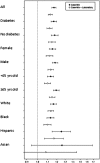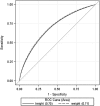Association of Height with Mortality in Patients Undergoing Maintenance Hemodialysis
- PMID: 25825484
- PMCID: PMC4455209
- DOI: 10.2215/CJN.07970814
Association of Height with Mortality in Patients Undergoing Maintenance Hemodialysis
Abstract
Background and objectives: Body mass index (BMI), determined as kilograms in body weight divided by the square of the height in meters (m(2)), is inversely associated with mortality in patients undergoing maintenance hemodialysis (MHD). It is commonly inferred that differences in the weight component of the BMI equation are responsible for this negative correlation. However, there are almost no data on the relationship between height and mortality in these patients. This study was conducted to examine the association between height and mortality in MHD patients and to evaluate the contribution of height to the BMI-mortality relationship.
Design, setting, participants, & measurements: A prospective study conducted from July 1, 2001, through June 30, 2006, enrolled a nationally representative cohort of 117,644 MHD patients receiving treatment in DaVita, Inc. outpatient dialysis facilities with (1) known height and weight, (2) age ≥18 years, (3) dialysis vintage ≥90 days, and (4) nonoutlying BMI values (≥12 to ≤60 kg/m(2)). The end date of follow-up was June 30, 2007, and median follow-up was 852 days (interquartile range, 504-1367 days). Mortality hazard ratios were computed within sex-standardized deciles of height and weight, and outcomes included all-cause mortality and cardiovascular, gastrointestinal, cancer, and infection mortality. Hazard models were unadjusted, adjusted for case-mix variables, or adjusted for case-mix variables plus laboratory variables.
Results: Mean age was 61±15 years; 45% of patients were women and 57% had diabetes. In adjusted models, height, also adjusted for weight, was directly associated with all-cause mortality and cardiovascular, infection, and cancer mortality. Compared with the median height decile, mortality risk in the highest height decile was 1.18 (95% confidence interval, 1.14 to 1.23) in fully adjusted analyses (P<0.001). Receiver-operating characteristic curves indicated that in adjusted analyses the contribution of height to the relationship between BMI and mortality was almost identical to that of weight.
Conclusions: In MHD patients, height is positively associated with mortality risk and contributes similarly to weight with regard to the negative BMI-mortality relationship.
Keywords: body mass index; chronic renal disease; clinical epidemiology.
Copyright © 2015 by the American Society of Nephrology.
Figures





Comment in
-
You're Not Big--You're Just Tall, That's All!J Am Soc Nephrol. 2016 Feb;27(2):339-41. doi: 10.1681/ASN.2015070816. Epub 2015 Oct 1. J Am Soc Nephrol. 2016. PMID: 26429919 Free PMC article. No abstract available.
References
-
- Kalantar-Zadeh K, Abbott KC, Salahudeen AK, Kilpatrick RD, Horwich TB: Survival advantages of obesity in dialysis patients. Am J Clin Nutr 81: 543–554, 2005 - PubMed
-
- Johansen KL: Association of body composition with survival among patients on hemodialysis. Clin J Am Soc Nephrol 5: 2144–2145, 2010 - PubMed
-
- Leavey SF, McCullough K, Hecking E, Goodkin D, Port FK, Young EW: Body mass index and mortality in ‘healthier’ as compared with ‘sicker’ haemodialysis patients: results from the Dialysis Outcomes and Practice Patterns Study (DOPPS). Nephrol Dial Transplant 16: 2386–2394, 2001 - PubMed
-
- Jousilahti P, Tuomilehto J, Vartiainen E, Eriksson J, Puska P: Relation of adult height to cause-specific and total mortality: A prospective follow-up study of 31,199 middle-aged men and women in Finland. Am J Epidemiol 151: 1112–1120, 2000 - PubMed
-
- Song YM, Sung J: Adult height and the risk of mortality in South Korean women. Am J Epidemiol 168: 497–505, 2008 - PubMed

